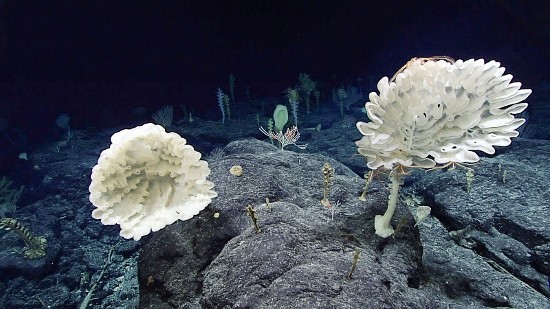The ink hasn’t yet dried on the newest international agreement to protect vast areas of the global ocean from human predation, yet a two-week meeting starting in Kingston, Jamaica, today could lead to the beginning of deep-sea mining of the ocean floor this year.
The International Seabed Authority (ISA), headquartered in Jamaica, is the UN intergovernmental body representing 167 countries and responsible for regulating deep-sea mining in areas beyond national jurisdiction and with ensuring the effective protection of the marine environment. Jamaica is hosting the meeting.
A miner, The Metals Company, is attending to ask for a green light to begin commercial deep-sea mining operations this coming July. The company wants to execute its agreement with the Pacific island of Nauru where it previously established a wholly-owned subsidiary, Nauru Ocean Resources Inc., responsible for the NORI-D Project.
The Deep Sea Conservation Coalition (DSCC), an alliance of over 100 organizations across the globe involved in promoting biodiversity conservation, is also in attendance. DSCC is advocating for a moratorium on deep-sea mining and calling on the ISA to make environmentally responsible decisions on behalf of all humanity.
States Sofia Tsenikli, Global Campaign Lead at DSCC, “It is unthinkable that deep-sea mining could be greenlighted this year. By allowing the strip-mining of one of the last wilderness areas of our planet, our generation would literally be scraping the bottom of the barrel, repeating the same mistakes that brought us to the biodiversity and climate crisis”.
DSCC isn’t alone in raising a red flag about the project. Many other environmental groups, youth groups, and businesses are also calling for a moratorium or ban on strip-mining of the ocean floor.
Scientists are warning that any approval of deep-sea mining would lead to irreversible biodiversity loss to ocean ecosystems. They also have cautioned that deep-sea mining could compromise the planet’s largest carbon sink, the deep ocean.
States Emma Wilson, DSCC Policy Officer, “No mining should be allowed when there is still no comprehensive scientific knowledge of deep-sea ecosystems or the risks and associated impacts of deep-sea mining.” She continues, “Anything less would be a dereliction of government’s duties under the United Nations Convention on the Law of the Sea to protect the marine environment and would undermine international commitments to tackle the dual crises of climate change and biodiversity loss.”
Countries joining DSCC include Costa Rica, Chile, Ecuador, France, Federated States of Micronesia, Fiji, Germany, New Zealand, Palau, Panama, Samoa and Spain.
The Metals Company has been working on NORI-D since 2011 when it was first granted an exploration contract in the Clarion Clipperton Zone, an area of geological submarine fractures on the floor of the Pacific Ocean, and covering approximately 4,500,000 square kilometres (1,700,000 square miles). The company has conducted comprehensive seabed-to-surface research and has discovered the largest undeveloped nickel deposit in the world on the ocean floor.
The company also has exploration contracts granted by ISA to do underwater surveys and sampling. It has formed two other subsidiaries, TOML, in association with Tonga; and DeepGreen Engineering Pte. Ltd. with the Kiribati government. The results so far point to an abundance of high-grade metals that could be used in 280 million electric vehicles (EVs). Half of the estimated quantity would come from NORI-D.
In its final argument, The Metal Company states that its operations would contribute to reducing greenhouse gas emissions because deep-sea mining would produce 90% less carbon dioxide than land-based equivalents. Further, seafloor mining would not impact land use. There would be no disruption of indigenous communities, no deforestation, and no polluting of freshwater sources.
Collecting The Rocks
The mining plan as described by The Metal Company sounds very different than how it is described by its opposition. The company states it would “pluck” manganese nodules containing four essential battery metals, cobalt, nickel, copper and manganese off the sea floor. The nodules are there for the taking. They have precipitated from seawater and sediment and are just lying there. Its operations would be unlike mining on land with no toxicity leaks, no tailings, and no solid waste left behind. The mining would be efficient in harvesting almost all of the metal content in every nodule.
The opposition, however, describes the mining of the sea floor as equivalent to surface strip mining. They talk about the equipment gouging the seafloor surface and destroying life like the Farreid glass sponges seen in the picture posted at the top of this article.
The opposition also questions the need for these metals as battery technology evolves. It states that the battery industry is moving away from these metals in next-generation technology and that recovery and reuse of the metals can be done using recycled materials.
The last word goes to Matthew Gianni, a Co-Founder of DSCC, who states, “Instead of opening up a whole new frontier of large-scale industrial resource extraction and loss of biodiversity….we need instead to develop smarter, low impact, circular technologies and make better use of the resources we already have.”
He adds: “Our ocean is already under stress from plastics, pollution, overfishing and climate change impacts. At a time of converging biodiversity and climate crises, why would the 167 member countries of the ISA agree to add to these stressors by allowing deep-sea mining to go ahead?”










[…] use in electric batteries. That’s why The Metals Company, a prospective deep-sea miner, has signed agreements with the island nations of Nauru, Kiribati and the Kingdom of Tonga, who own the commercial rights […]